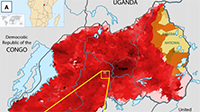 eScience’s Joshua Blumenstock’s paper on Predicting Poverty and Wealth From Mobile Phone Metadata — featured as a research project on our website — was published recently in the journal Science, and also received a great write-up from UW’s Information School.
eScience’s Joshua Blumenstock’s paper on Predicting Poverty and Wealth From Mobile Phone Metadata — featured as a research project on our website — was published recently in the journal Science, and also received a great write-up from UW’s Information School.
Co-authored by Gabriel Cadamuro and Robert On, the paper focuses on using mobile phone metadata to estimate the distribution of wealth and poverty.
Blumenstock, quoted from the iSchool article: “Quantitative, rigorous measurements are key to making important decisions about social welfare allocation and the distribution of humanitarian aid. But in a lot of developing countries high-quality data doesn’t exist. What we show in this paper, and I think fairly clearly, is that phone data can be used to estimate wealth and poverty.”
The team’s research was conducted in the East African nation of Rwanda, where mobile phone use is ubiquitous across the country’s population of 11 million. Interviewing 1,000 random mobile users in the country, and combining that with metadata provided by one of the country’s mobile network providers, patterns emerged from the data to help the team “determine the hallmarks of socioeconomic status.”
“In practice it’s not simple,” Blumenstock continues in the iSchool story. “We use supervised machine learning algorithms to sort through thousands of patterns to figure out what is most correlated with wealth and poverty. But once we know which mobile phone patterns are indicative of wealth, we can extrapolate to the country’s one and a half million cell phone users. We just see for each person thereafter what pattern they follow — the wealthy pattern or the poor pattern.”
Both the Science publication and the accompanying iSchool story are great reads, and we’ve included the paper’s abstract below.
Congratulations to Josh and team!
Abstract: Accurate and timely estimates of population characteristics are a critical input to social and economic research and policy. In industrialized economies, novel sources of data are enabling new approaches to demographic profiling, but in developing countries, fewer sources of big data exist. We show that an individual’s past history of mobile phone use can be used to infer his or her socioeconomic status. Furthermore, we demonstrate that the predicted attributes of millions of individuals can, in turn, accurately reconstruct the distribution of wealth of an entire nation or to infer the asset distribution of microregions composed of just a few households. In resource-constrained environments where censuses and household surveys are rare, this approach creates an option for gathering localized and timely information at a fraction of the cost of traditional methods.

